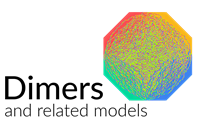The dimer model comes from statistical mechanics. Many quantities related to the model can be found explicitly, and this makes it a useful surrogate, especially when studying phase transitions. These arise everywhere in nature and are very complex, so being able to study them through an analytically tractable approximation is immensely useful. The dimer model also connects statistical mechanics and probability with other areas of mathematics, such as algebra and geometry. This workshop will explore these connections.

13:00 - 13:10 Opening
13:10 - 14:00 Sanjay Ramassamy: "Dimers and t-embeddings"
14:00 – 14:50 Qian Wei: "Dimer model with monomers on the boundary"
14:50 - 15:20 Break
15:20 - 16:00 Panel discussion and extended questions
16:00 - 16:50 Istvan Prause: "The genus-zero five-vertex model"
16:50 - 17:00 Closing remarks
Talks:
Sanjay Ramassamy - Dimers and t-embeddings
In this talk I will describe a correspondence between dimer models on a
planar bipartite graph and t-embeddings, namely embeddings arising as
centers of circle patterns with the combinatorics of the bipartite
graph. This correspondence behaves well under local transformations of
the bipartite graph and is expected to provide the right setting for
observing conformally invariant scaling limits. This is based on joint
works with Dmitry Chelkak (École normale supérieure), Richard Kenyon
(Yale University), Wai Yeung Lam (BIMSA) and Marianna Russkikh (MIT).
Istvan Prause - The genus-zero five-vertex model
The five-vertex model is a probability measure on monotone
nonintersecting lattice path configurations on the square lattice where
each corner-turn is penalised by a weight. I’ll introduce an
inhomogeneous “genus-zero” version of this non-determinantal model and
study its limit shape problem. That is, we are interested in the typical
shape of configurations for large system size and fixed boundary
conditions. We derive the exact phase diagram, free energy and surface
tension for this model and give explicit parametrisations of limit
shapes. Some new features beyond dimers characteristic to the
non-determinantal setting will be discussed. The talk is based on joint
works with Rick Kenyon.
Qian Wei - Dimer model with monomers on the boundary
Abstract TBC.
- Sanjay Ramassamy (CNRS, CEA Saclay)
- Qian Wei (CNRS, Université Paris-Saclay)
- Istvan Prause (University of Eastern Finland)
RSS Applied Probability Section
Sunil Chhita (Durham University)
Alex Watson (UCL)
Fellow: Free
GradStat / CStat: Free
E-Student: Free
Non-Fellow: £10.00